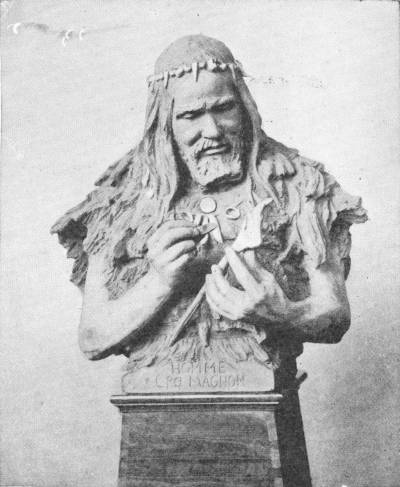




BONE CARVINGS OF THE PALÆOLITHIC PERIOD
(1 and 2) Mammoth tusk carved to shape of Reindeer, (3) Dagger Handle representing Mammoth, and (4) Bone engraved with Horses? Heads
Brit. Mus.
And these savages of perhaps forty thousand years ago were so human that they pierced shells to make necklaces, painted themselves, carved images of bone and stone, scratched figures on rocks and bones, and painted rude but often very able sketches of beasts and the like upon the smooth walls of caves and upon inviting rock surfaces. They made a great variety of implements, much smaller in scale and finer than those of the Neanderthal men. We have now in our museums great quantities of their implements, their statuettes, their rock drawings and the like.
The earliest of them were hunters. Their chief pursuit was the wild horse, the little bearded pony of that time. They followed it as it moved after pasture. And also they followed the bison. They knew the mammoth, because they have left us strikingly effective pictures of that creature. To judge by one rather ambiguous drawing they trapped and killed it.
They hunted with spears and throwing stones. They do not seem to have had the bow, and it is doubtful if they had yet learnt to tame any animals. They had no dogs. There is one carving of a horse?s head and one or two drawings that suggest a bridled horse, with a twisted skin or tendon round it. But the little horses of that age and region could not have carried a man, and if the horse was domesticated it was used as a led horse. It is doubtful and improbable that they had yet learnt the rather unnatural use of animal?s milk as food.
They do not seem to have erected any buildings though they may have had tents of skins, and though they made clay figures they never rose to the making of pottery. Since they had no cooking implements their cookery must have been rudimentary or nonexistent. They knew nothing of cultivation and nothing of any sort of basket work or woven cloth. Except for their robes of skin or fur they were naked painted savages.
These earliest known men hunted the open steppes of Europe for a hundred centuries perhaps, and then slowly drifted and changed before a change of climate. Europe, century by century, was growing milder and damper. Reindeer receded northward and eastward, and bison and horse followed. The steppes gave way to forests, and red deer took the place of horse and bison. There is a {57} change in the character of the implements with this change in their application. River and lake fishing becomes of great importance to men, and fine implements of bone increased. ?The bone needles of this age,? says de Mortillet, ?are much superior to those of later, even historical times, down to the Renaissance. The Romans, for example, never had needles comparable to those of this epoch.?
